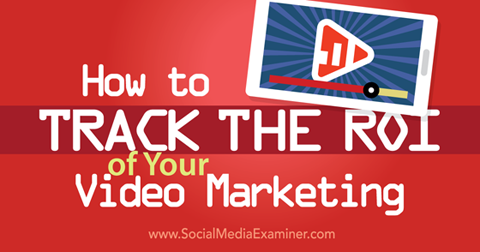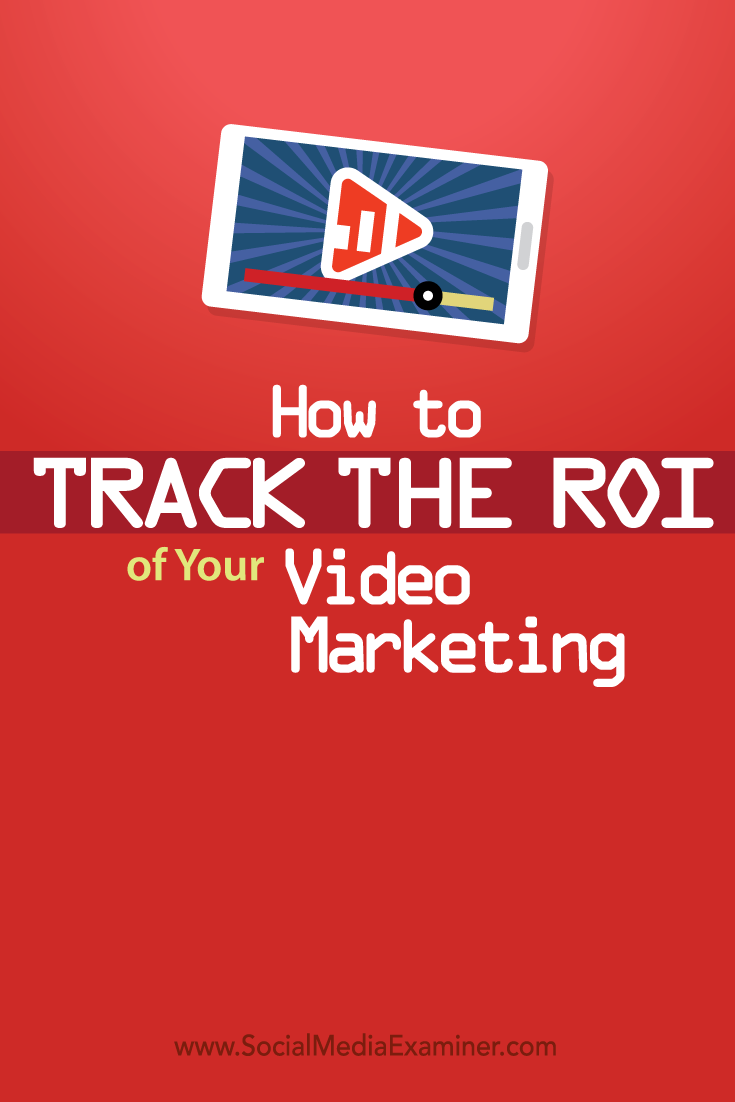 Are you struggling to measure the ROI of your marketing videos?
Are you struggling to measure the ROI of your marketing videos?
Looking for tools to help track sales from your videos?
A simple framework and a few tools can reveal if your video campaigns are working for you.
In this article you'll discover how to track and measure the ROI for your video marketing efforts.

Listen to this article:
Where to subscribe: Apple Podcasts | Spotify | YouTube Music | YouTube | Amazon Music | RSS
#1: Outline Your Campaign Costs
Take the time to do a complete breakdown of all of the projected costs of your video marketing campaign, including the marketing hours you'll spend promoting it.
Include a buffer of at least 20% of your projected expenses if you manage the campaign on your own. This buffer will be used for unexpected costs, such as having to reshoot footage or invest more in editing.
Keep in mind that there are video marketing companies that offer all-inclusive video marketing packages, and this can make doing a cost outline much easier and more effective.
#2: Determine the Financial Tipping Point
Think about how many sales you need to make from your video marketing campaign to break even. After you reach your break-even amount, everything else will be pure profit. But first you need to determine that amount.

You can make this a very simple process. For example, if your video marketing campaign has a budget of $5,000 per month, you should expect to see your monthly sales go up by more than $5,000. If your average sale is $100, you already know that you'll need to make at least 50 sales to compensate for the cost of the video.
You should track your sales (and other metrics) year–over–year in addition to month–by–month to make sure that you've adjusted for any seasonal changes.
#3: Track Sales From Your Video Campaign
That's all easy enough, but now you need to differentiate income from your video campaign from income from other marketing factors.
To distinguish your video campaign from other marketing factors, you can always track people who flow from your video and go on to make a purchase. Do this by using web tools to embed links that are specific to your videos.

Keep in mind that these won't track all of your sales. There will always be people who see your video and make a purchase later on or in a non-traditional way, so you'll need to inflate your sales slightly to get a true ROI. The benefit, naturally, is that you'll know that your video made you at least that amount of money.
Get World-Class Marketing Training — All Year Long!
Are you facing doubt, uncertainty, or overwhelm? The Social Media Marketing Society can help.
Each month, you’ll receive training from trusted marketing experts, covering everything from AI to organic social marketing. When you join, you’ll also get immediate access to:
- A library of 100+ marketing trainings
- A community of like-minded marketers
- Monthly online community meetups
- Relevant news and trends updates
Use any one of these tools separately or combine them for more complete video marketing campaign analysis.
Brandwatch makes it easy to quantify your company's brand awareness. Through this tool, you can identify brand sentiments to see if your campaign is working and whether you‘re building brand awareness in a positive, meaningful way.
Clicky allows you to break down website visitors into marketing demographics and track their activity live. If you're hosting your own videos (rather than uploading them through a service), this is an ideal way to get a better picture of your audience. Audience demographics can be critical in determining not only your ROI and awareness, but also why a particular strategy may not be working (you're targeting the wrong demographic entirely, for example).

Discover Proven Marketing Strategies and Tips
Want to go even deeper with your marketing? Check out the Social Media Marketing Podcast! Publishing weekly since 2012, the Social Media Marketing Podcast helps you navigate the constantly changing marketing jungle, with expert interviews from marketing pros.
But don’t let the name fool you. This show is about a lot more than just social media marketing. With over 600 episodes and millions of downloads each year, this show has been a trusted source for marketers for well over a decade.
Wistia offers one of the most advanced video analysis suites available. Not only does this tool provide demographic information, but it can also directly track engagement. You can see how long visitors watched and what actions they took when they finished watching. This includes any purchases that they may have made. Wistia can integrate into your sales funnel and give you critical information about optimizing your video marketing results.
YouTube offers analytics such as YouTube Insights that will break down your viewership by demographic and track outgoing clicks. You can embed marketing prompts directly into your YouTube videos so you can funnel your viewers directly into a sales channel.
#4: Improve Your Video Marketing Campaigns
Once you've measured your ROI, it's time to look at ways to improve it. Any marketing campaign needs time to grow and develop, but there are tactics that you can use to improve your metrics. Video marketing campaigns are not special in this respect. They require the same type of management, optimization and analysis as other types of marketing campaigns.

Start by looking back at your analysis and asking yourself a few critical questions:
Is your campaign targeted to your core demographics? Once you have your video demographics in hand, you'll have a better picture of your interested demographics. At this time, you may want to drill down and start targeting these demographics specifically.
Are any core audience demographics responding negatively to this campaign? For instance, your campaign could be performing negatively among the 20- to 30-year-old male demographic. If this is one area in which you'd like to make sales, it may be advantageous to determine why.
Are viewers abandoning your video marketing? And if so, why? Marketing abandonment will happen. People may not be in the mood for a video or may simply have clicked the wrong link. But if you're seeing large numbers of abandonment, it's time to figure out why. You can use a tool such as Wistia to see where people are abandoning your video to draw further conclusions.
Is your video marketing campaign giving customers a solid call to action? If your video audience isn't converting, it may be that people aren't certain what steps they should take next. Your video marketing should always be clear on what action viewers should take, even if it's simply requesting more information or viewing another video.
Are viewers continuing to engage with your brand? There are two types of viewers: those who will see your video once and move on, and those who will establish a relationship with your company and continue to engage. You want to foster engagement. If your viewers are clicking out and never coming back, consider boosting your social media visibility and encouraging them to interact.

Answer the above questions to get a more concrete idea of what areas you need to improve. Following this, you just need classic A/B or split testing. Test new marketing strategies alongside the old, and figure out which one performs best. Keep refining the best, most effective strategies, and eventually you'll see a meaningful increase in return.
Conclusion
Measuring ROI doesn't have to be complicated. If you want a general revenue picture, all you need to do is to isolate how much your video costs and how much your sales went up. If you want a more complete revenue picture, use tracking and analysis tools. Now get measuring!
What do you think? Have you used these tactics to measure ROI for your video marketing campaigns? What techniques work well for your business? Please share your thoughts in the comments below.
Cost profit graph photo, Video marketing key photo, Marketing effectiveness photo and Return on Investment photo from Shutterstock.

Attention Agency Owners, Brand Marketers, and Consultants

Introducing the Marketing Agency Show–our newest podcast designed to explore the struggles of agency marketers.
Join show host and agency owner, Brooke Sellas, as she interviews agency marketers and digs deep into their biggest challenges. Explore topics like navigating rough economic times, leveraging AI, service diversification, client acquisition, and much more.
Just pull up your favorite podcast app, search for Marketing Agency Show and start listening. Or click the button below for more information.

